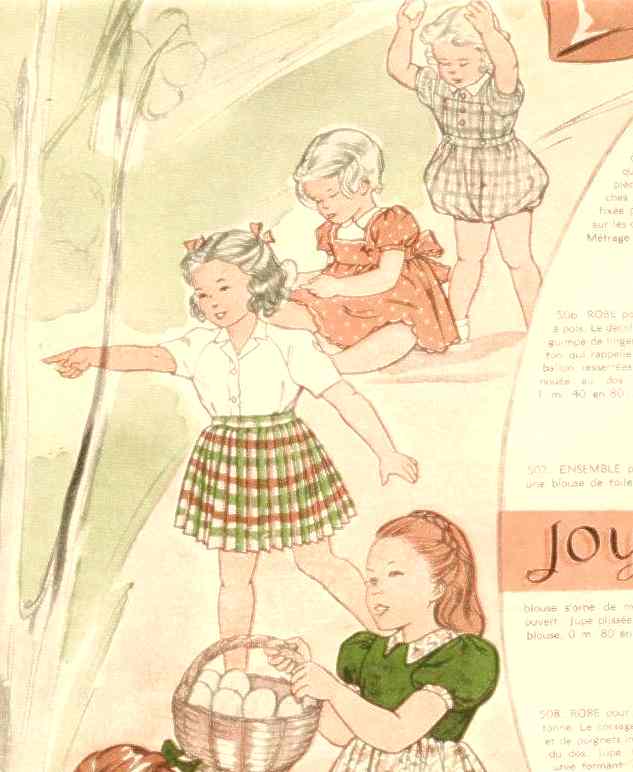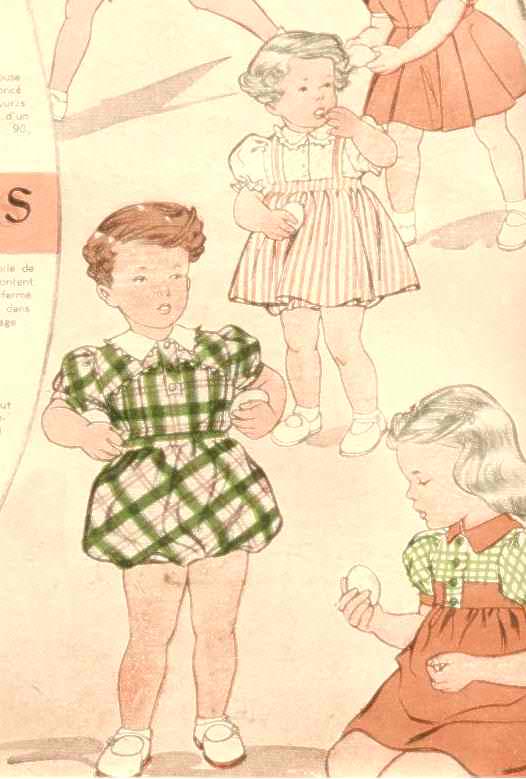
Figure 1.--Mode pratique in April 1947 showed French children gatherings eggs for Easter. The girls all wore dresses or skirts. The two boys pictured were of different ages. Both wore romper outfits, each both were one-piece style romper suits.


Figure 1.--Mode pratique in April 1947 showed French children gatherings eggs for Easter. The girls all wore dresses or skirts. The two boys pictured were of different ages. Both wore romper outfits, each both were one-piece style romper suits. |
Many different styles of barboteuses or other outfits with puffed pants were shown in French fashion magazines. Mode pratique in April 1947 showed French children gatherings eggs for Easter. The girls all wore dresses or skirts. The two boys pictured were of different ages, both infants and toddlers in sizes up to age 4. Both wore romper outfits, each boy is pictured in a one-piece style romper suits. Only one, however, was referred to as a romper suit or barboteuse.
Barboteuses, ensembles or costumes? These garments were always called "barboteuse" by French mothers. Only in magazine or advertisemenrs were sometimes referred tonas a costume or ensemble. Some times these terms were used to differentiate between traditional romper suits and other similar garments with puff pants.
The Mode pratique in April 1947 showed French children gatherings eggs for Easter. The girls all wore dresses or skirts. The two boys pictured were of different ages. Both wore romper outfits, each both were one-piece style romper suits. Inclusion in the April issue of course meant that they were outfits seem suitable for the Easter wear.
The younger boy wears what looks to be a front-buttoning one piece plaid gingam romper suit with both puff sleeves and puff pants. There is a white, pointed collar. There does no look to be a back bow, but with this front view it is difficult to tell. The ad copy reads, "505. Ensemble pour 1 à 2 ans en toile de Vichy quadrillée. La blouse s'orne devant de deux plis creux qui se terminent dans l'empiècement. Col rabattu, manches ballon. Culotte bouttante fixée par 4 boutons et resserrée sur les cuisses par deux élastiques.
Métrage: 1 m 50 en 80." That means, "505. Outfit for boy 1 to 2 years old , in squared Gingham . The bodice is trimmed in front by two box pleats which end into the yoke. False collar; balloon sleeves. Puffed pants; fixed by 4 buttons and tighten on the thights
by two elastics. Material needed: 1,50 meter in cloth of 0,80 meter wide." The romper suit look very similar to the toddler romper. I'm not sure why it is not also called a barboteuse. Bothe the romper suits were front buttoning, back buttoning romper suits were more common.
The todler boy wears a front-buttoning one piece plaid gingam romper suit that looks very similar to what the younger boy wears. Both have puff sleeves and puff pants. There is a white, pointed collar. There does no look to be a back bow, but with this front view it is difficult to tell. The only minor differences we note are that the collar has trim and the front of the romper has some minor detailing while the romper fpr the younger boy is slightlybplainer. The ad copy reads, "
"513. Barboteuse pour 2 à 4 ans en toile de Vichy. Deux plis de chaque côté se montent dans l'empiècement découpé. Col rabattu fermé sous une patte. Culotte bouffante froncée dans la ceinture. Garniture de croquet. Métrage 1 m 60 en 80." " That means, 513 . Romper for 2-4 years old in Gingham cloth. Two pleats on each side are sewed into the cut-two-pieces yoke. False collar closed under a flap. Puffed pants gatherd in the belt. Trim with braid. Material needed: Length 1,60 meter in 0,80 meter wide Gingham."

Figure 2.--Mode pratique in April 1947 showed French children gatherings eggs for Easter. The girls all wore dresses or skirts. The two boys pictured were of different ages. Both wore romper outfits, each both were one-piece style romper suits. |
Patterns for the rompers shown here look like rather dressy romper suits (figures 1 and 2). They could be ordered from the magazine. In addition to the ropers here, the April issue also included a basic pattern for another romper suit. An ilustration with this pattern showed a romper suit for a boy and a matching dress for a little girl. The hildren are pictured as playing by a pond, so presumably this is a style for outdoor play rather than formal or dress wear. It looked like a one-piece romper made in plaid gingham. There does not look to be a back bow. The top of both the dress and romper have puff sleeves and front buttons and look identical.
Many different styles of barboteuses or other outfits with puffed pants were shown in French fashion magazines. A French reader tells us, "But regaring garments actually sold, iy was the traditional barboteuse that sold in the largest quantities. This was certainly the case in the store operated by my parents as well as the suits I saw children commonly wearing. About 90 percent of the barboteuses my parents sold were the traditional one-piece style with puff sleeves and big bow in the back. Practically always they were back buttoning. They were done in in Vichy , or Popeline, or wool. Often mothers or grandmothers knitted them. All had croch buttons. Rompers were one of the principal garment for the boys till 4-5 years old throughout the year. Some boys wore them even longer having a dressy romper suit that they might wear on Sunday or other special occassions untill 6-7 years of age. On especially cold days in winter, boys might wear
long knitting wool pant. (I never wore these as I lived in the south of France where it is warmer.) Rompers with long sleeves were much less common. It seems that French mothers when it was chilly preferd to add a wool sweater open at the front. Some boys in winter also wore white wool underpants and undershirts (vests) under their clothes instead of the normal cotton ones."
La Mode Pratique was a very popular fashion magazine in France." It included both fashion information and patterns. We have few details on the publishing history of the magazine at this time. We do note that it was published during the 1920s. We do not yet know, however when it was founded or ceased publication. It appears to have had considerable information about children's clothing. We do know that it was published throughout the 1930s-40s and into the 50s. We had thought that Mode pratique was a monnthly, but during the 1940os it seems to have been issued twice monthly.
Easter is called Pâques in France. It is one of the most impoprtant holiday celebrations for French children. As in America and many other European countries, the religious message
of Easter is increasingly being drowned out by te commercialization of the holiday. The
children as in many other country receive colorfully decorated eggs. The French begin their
Easter season several weeks before Easter actually begins. Shop windows are gayly
decorated in a festive collection of white and dark chocolate rabbits, chickens, bells and
fish. Much of this occurs in other countries, but bells and fish are an important part of the French Easter tradition.
A French reader tells us, "I was still wearing rompers in 1947. I still have my last two-pieces romper outfit which I wore, I think, at about age 6 years. It had croch buttons, suspenders, but the blouse is with front buttons. I quite recall having worn it in Paris and probably elesewhere. I wore rompers much longer than my younger brother did."
Navigate the Boys' Historical Clothing catalog/magazine pages:
[Return to the Main French mail order 1947s page]
[Main photo/publishing page]
[Store catalogs]
[Fashion magazines]
Navigate the Boys' Historical Clothing Web Site:
[Introduction]
[Activities]
[Biographies]
[Chronology]
[Clothing styles]
[Countries]
[Bibliographies]
[Contributions]
[FAQs]
[French glossary]
[Satellite sites]
[Tools]
[Boys' Clothing Home]
Navigate the Boys' Historical Clothing Web Site:
[Sailor suits]
[Sailor hats]
[Buster Brown suits]
[Eton suits]
[Rompers]
[Tunics]
[Smocks]
[Pinafores]
